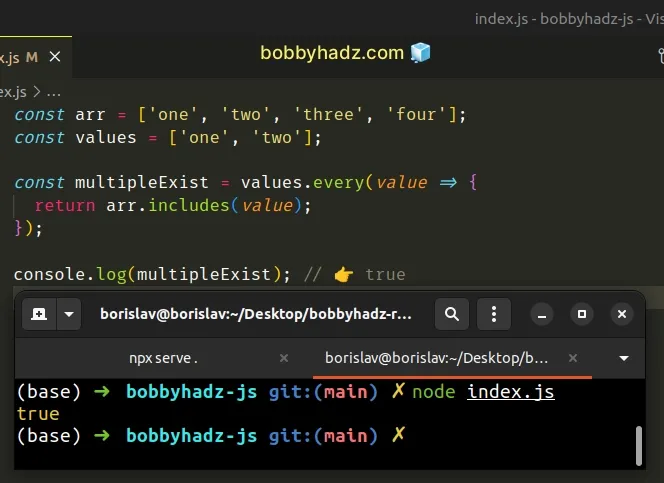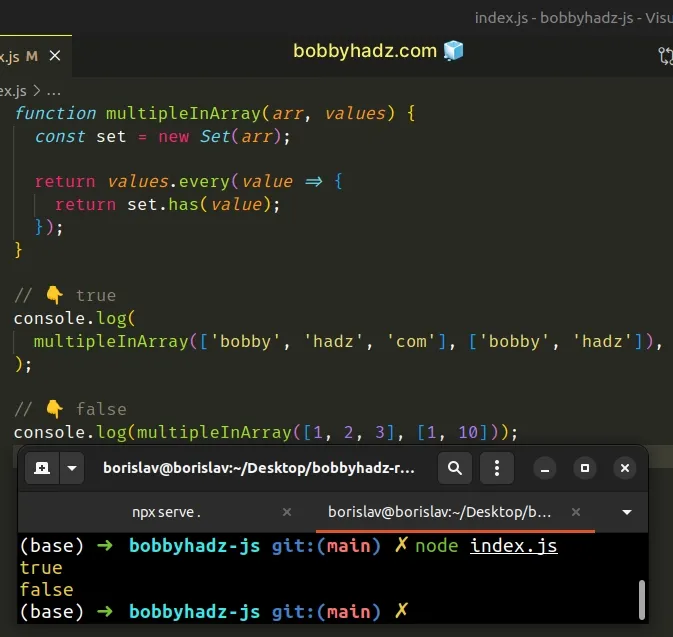Check if Multiple Values exist in Array in JavaScript
Last updated: Mar 3, 2024
Reading time·3 min

# Check if Multiple Values exist in an Array in JavaScript
To check if multiple values exist in an array:
- Use the
every()method to iterate over the array of values. - On each iteration check if the value is contained in the other array.
- If all values exist in the array, the
everymethod will returntrue.
const arr = ['one', 'two', 'three', 'four']; const values = ['one', 'two']; const multipleExist = values.every(value => { return arr.includes(value); }); console.log(multipleExist); // 👉️ true

The function we passed to the Array.every method gets called with each element until it returns a falsy value or iterates over the entire array.
On each iteration, we use Array.includes() method to check if the value is contained in the other array.
const arr = ['one', 'two', 'three', 'four']; console.log(arr.includes('one')); // 👉️ true console.log(arr.includes('two')); // 👉️ true console.log(arr.includes('abc')); // 👉️ false
If even a single value is not contained in the array, the includes() method
returns false, which causes the every method to short-circuit also returning
false.
If you need to do this often, define a reusable function.
function multipleInArray(arr, values) { return values.every(value => { return arr.includes(value); }); } console.log(multipleInArray([1, 2, 3], [1, 3])); // 👉️ true console.log(multipleInArray([1, 2, 3], [1, 10])); // 👉️ false
The multipleInArray function takes an array and a collection of values and
checks if the specified values exist in the array.
If the condition is met for all values, the function returns true, otherwise,
false is returned.
# Check if multiple values exist in an array using a Set object
This is a three-step process:
- Convert the array to a
Setobject. - Use the
every()method to iterate over the array of values. - Use the
Set.has()method to check if each value is in theSet.
function multipleInArray(arr, values) { const set = new Set(arr); return values.every(value => { return set.has(value); }); } // 👇️ true console.log( multipleInArray(['bobby', 'hadz', 'com'], ['bobby', 'hadz']), ); // 👇️ false console.log(multipleInArray([1, 2, 3], [1, 10]));

We used the Set() constructor to
convert the array to a Set object to
remove all the duplicates (if any).
// 👇️ Set(3) { 1, 2, 3 } console.log(new Set([1, 1, 2, 2, 3, 3]));
Set objects are collections of unique elements, so if any duplicates exist in
the array, they get dropped once passed to the Set() constructor.
The next step is to use the Array.every() method to iterate over the array of
values.
On each iteration, we use the
Set.has()
method to check if the current value is contained in the Set object.
The Set.has method returns true if the value is contained in the Set and
false otherwise.
# Check if Multiple Values exist in an Array using indexOf()
This is a three-step process:
- Use the
every()method to iterate over the array of values. - Use the
indexOfmethod to check if each value is contained in the other array. - If all values exist in the array, the
everymethod will returntrue.
const arr = ['one', 'two', 'three', 'four']; const values = ['one', 'two']; const multipleInArray = values.every(value => { return arr.indexOf(value) !== -1; }); console.log(multipleInArray); // 👉️ true

This is very similar to our previous example. However, this time we used the Array.indexOf method.
indexOf method checks if a value is contained in an array and returns the index of the first occurrence of the value in the array.If the value is not contained in the array, the method returns -1.
If the indexOf method doesn't return -1, then the value is contained in the
array.
Here is a reusable function that achieves the same result.
function multipleInArray(arr, values) { return values.every(value => { return arr.indexOf(value) !== -1; }); } // 👇️ true console.log(multipleInArray([1, 2, 3], [1, 2])); // 👇️ false console.log(multipleInArray([1, 2, 3], [4, 2]));
The function takes the array and the collection of values as parameters and
returns true if all of the values are contained in the array and false
otherwise.
# Additional Resources
You can learn more about the related topics by checking out the following tutorials:
- Check if an Array contains Duplicates in JavaScript
- Count the Duplicates in an Array in JavaScript
- Prevent adding Duplicates to an Array in JavaScript
- Check if all Values in Array are Equal in JavaScript
- Check if Array has all Elements of Another Array - JavaScript
- TypeError: Cannot use 'in' operator to search for 'X' in 'Y'

